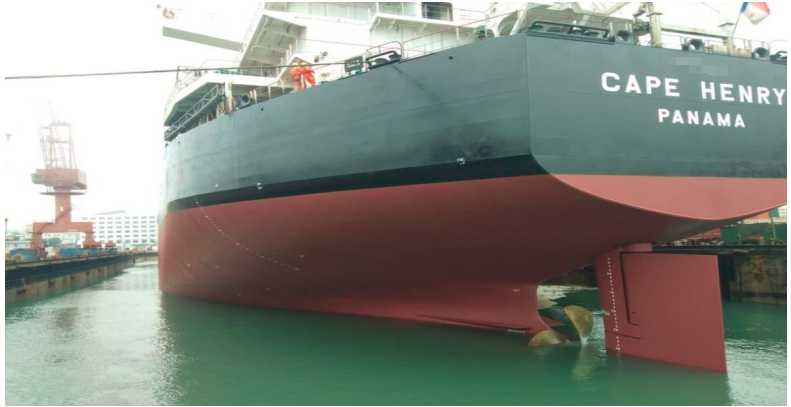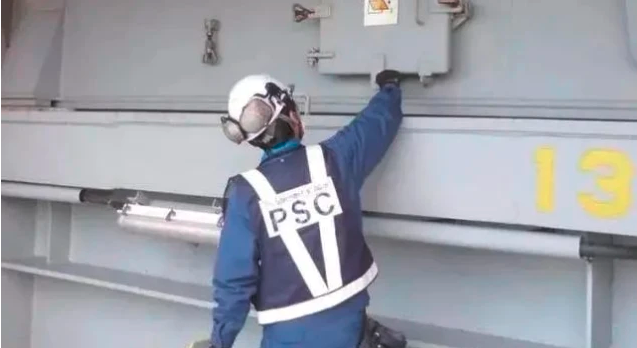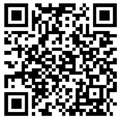船长分享 | 应对COVID-19下的PSC检查,船上该如何做准备?
随着COVID-19的爆发和在全球的大流行,使得航运业受到了前所未有的挑战。对于在船上工作和生活的船员而言,不但心理压力增加,同时工作中也增加了很多新的要求。比如当我轮M.V. UniBlossom挂靠加拿大太平洋区域(Pacific Region)时,除了很多有关COVID-19的报告要按要求在不同的时间完成和递交外,加拿大运输部(Transport Canada)很有可能在船停泊期间随时安排港口国监督检查(Port State Control Inspection)。 网络示意图(图源:国外网站) 而疫情期间与正常不同的是:港口国监督检查官员(PSCO)会提前1~2天发邮件通知船上,告知他们会登船检查,这本来是好事,能让船上提前做好迎接检查的准备工作。不过,虽然他们也知道时间紧迫(we understand your pressures),但是还是要船上尽快(It would be appreciated to have it done and returned as soon as possible)将他们要求的检查前资料(Prior to our visits),包括instructions and expectations, General information, questionnaire, vessel certificates, ports of call, crew information and crew change等按要求完成并发回给他们。 这些要求对于有经验的船长而言,倒也不算什么难事;问题是,在instructions and expectations中,他们要求“Please provide a copy of your vessel’s COVID-19 procedure”——这个要求如果不认真阅读,还真会被忽略,因为他们的instructions and expectations太多了,满满的几十行。尽管国际上或每个船东或多或少都有一些关于COVID-19的介绍和/或要求/指导,不过我相信大多数船(包括我们船)都没有vessel’s COVID-19 procedure,特别是英文的。 当时收到他们的通知时,已经是中午了,船计划第二天靠泊(温哥华Vancouver)。为了能给港口国监督检查官员(PSCO)留下“美好的初步印象”,作为船长,我迅速整合资料,编制了本文下面我轮的COVID-19 procedure,连同他们要求的其它信息,并在当天下午五点之前(Duringoffice hours)发给了港口国监督检查官员(PSCO)。 不知道是不是我们的迅速行动(quickresponse)真的给他们留下了“美好的印象”,我船在加拿大温哥华停留了4天时间,原定访船的港口国监督检查官员(PSCO)最后竟然没有来。我们虽然松了口气(毕竟装散粮,在港也是很忙碌的),不过内心还是有点点失落:我们为港口国监督检查,做了大量的准备,临了却“无用武之地”——我们船一年多前在温哥华港口国监督检查时曾经被写过一条缺陷(Deficiency),说实话,这回我们是憋了一口气想扳回点面子的。毕竟我们二十天前刚刚在美国的Long Beach也是零缺陷通过USCG的港口国监督检查,信心正足。 闲暇时,将vessel’s COVID-19 procedure稍微修改了下,将情况简单做一下介绍,供同行参考,如有不准确的地方,欢迎交流指正。

网络示意图(图源:国外网站)
Due to the pandemic of COVID-19 globally, seafarers on board arefacingsevere situation and/orparticular challenges to carrying out their functions and maintainingourhealth conditionin the time ofthe COVID-19. This Shipboard Procedure against COVID-19 providesguidance on protecting seafarers working on board and management ofCOVID-19 cases that may occuron board m.v. Uni Blossom,which should be observed and followed upaccordingly.
1.Officerin charge of the implementation of shipboard COVID-19 procedure
2/Ois designated to take charge of medical care and the implementationof shipboard COVID-19 procedure on board the ship.In case 2/O fails to perform this designated responsibility, C/Oshould be the substitute.
2.CrewChange
1.1 All theon-signers mustbe subject toPre-boarding screening to identify any symptomatic individuals orthose exposed to COVID-19. If any symptoms are identified, then theperson should not travel and instead seek medical care.
1.2 All theon-signersare to complete a locator card
1.3 SSD should berigorously maintained during the handover
1.4 Carry outshipboard training on COVID-19 for the on-signers, including butnot limited to
(1)Signsand symptoms of COVID-19
(2)Proceduresthat are to be followed when a person displays signs and symptomssuggestive of COVID-19,
(3)Rules aboutisolation of crew members who develop symptoms suggestive ofCOVID-19.
(4)Hand hygiene,respiratory etiquette and social distancing.
3.Createfour zones and procedure categories on board
(1)Potentiallycontaminated zones
(2)Zoneswhere only crew interact
(3)Zonesor activities where crew members interact with shore personnel
(4)Zoneswhere no interaction takes place among crew members or among crewmembers and shore personnel.
4.PPE
2/Oshould gointo details for the actual ROB of PPE against COVID on board atleast once per week and applyfor PPE inadvance so as to maintain sufficient protective materials (includingPPE) on board for at least 2 months consumption,taking the ship’sitinerary into account, against thelist of PPE instock as described in item 3 in the COVID record book.
5.Preventivemeasures
(1)Minimizethe number of non-crew members boarding the ship and ensure thatshore personnel move only into authorized zones.
(2)Shorepersonnel should be subject to body temperature observation and useouter walkways rather than gaining access through the crew’squarters; and be to wear protective masks from embarkation todisembarkation.
(3)Handhygiene stations, such as handwashing facilities and dispensers foralcohol-based hand rub, should be put in prominent places around theship and be accessible to all staff, contractors, customers andvisitors, along with communication materials that promote handhygiene and other preventive measures.
(4)Crewmembers must remain at least 1 m apart from one another and fromshore personnel. In situations in which physical distancing of atleast 1 m cannot be implemented in full, the master should considerwhether that activity needs to continue, and if it does, take allmitigating actions possible to reduce the risk of transmission.
(5)Avoidnon-essential contact or close proximity with other seafarers andother other persons
(6)Crewshould return back to their cabin after working hours
(7)Ship’screw and shore personnel in different working zones on the ship
(8)Cleaningand disinfection in the shore personnel working zones should becarried out after shore personnel have disembarked.
(9)High-touchsurfaces on board the ship should be identified as priorities fordisinfection. These include doors and windows and their handles,kitchen and food preparation areas, countertops, bathroom surfaces,toilets and taps, touchscreen personal devices, keyboards on personalcomputers and work surfaces. The disinfectant and its concentrationshould be carefully selected to avoid damaging surfaces and to avoidor minimize toxic effect.
6.Managingsuspected COVID-19 cases and their contact
(1)Themaster is to determine whether the situation is serious andnecessitates reaching out for immediate shore side medical supportand advice or radio medical assistance; or whether it can wait untilthe ship reaches the next port of call.
Shouldthe Master be in doubt, shore-based support from the followingexperts for medical advice couldbe available,
Dr.Wang Lei Mobile: 133 2331 5109
or
TheInternational Radio Medical Center (C.I.R.M.)
Telex:612068 C.I.R.M. I
Telephone:+39 06 59290263
MobileGSM Telephone: +39 348 3984229
Fax:+39 06 5923333
E-mail:telesoccorso@cirm.it
ItalianRadio Coastal Stations: Ask for C.I.R.M.
Telex:MEDRAD or DH MEDICO to obtain priority of transmission.
(2)Moderateand severe cases (cases that meet the case definition of COVID-19 andhave clinical signs of pneumonia, which include fever, cough, and abreathing respiratory rate of >20 breaths per minute) should bereported and transferred to a shore side medical facility.
(3)Contactsshould be quarantined for 14 days from the last time they wereexposed to the suspected case, if operationally safe to do so. If acontact develops any signs or symptoms, the contact should wear amedical mask and be treated as a suspected case. Persons who arequarantined need adequate food, water, and hygiene provisions.
7.Crewphysical condition monitoring
The2/O should take every crew’s body temperature at least twice a dayin the morning and in the afternoonand maintain the consistent record for every crew member on boardfrom their embarkation to their disembarkation;the Master should report the crew physical condition to owners ,managers and/or all the parties concerned as required (i.e. thecharters) ondaily basis.
8.Reporting
TheMastershouldget the Traveller contact information for each crew readily availableregardlessof whether ourcrewintend to go on shore leave, sign-off/discharge from the vessel, orif ourcrewintend to stay on board during the vessel's stop in portso as to submit the information to the authorities as requiredbecause it will be a lot of work andreply the COVID-19 Health screening questionnaire to the portauthorities in due course prior to arrival at each port of call inorder to prevent any finedue to contravention of the quarantine act/regulation/requirement;besides, the Master shouldalways informs the competent authority of next port of call if thereis a possible COVID-19 case on board.
9.Crewshoreside leaving
Ifshoreside visits are permitted, seafarers should follow WHO’srecommended public health and social measures, including the types ofPPE necessary, physical distancing measures and the availability ofhand hygiene facilities.
Additionalmeasures to be taken during shoreside visits include proper foodhygiene practices, including in live markets where transmission mayoccur from animals to humans.
10.Crewdisembarkation
Thehealth of the offsigners should be monitored prior to disembarkation.
Thecrew must comply with relevant public health regulations andpolicies, avoid contact with the public and fellow crew members, andremain in the hotel room except when seeking medical attention orperforming essential activities, including exercise, while respectingphysical distancing advice, not use public facilities in the hotel,dine in their room or if room service is not available, purchase foodfor takeaway or dine seated alone in a restaurant within the hotel,regularly self-monitor for symptoms including fever, observe goodhand and respiratory hygiene and physical distancing measures whenthey need to leave the hotel room.
11.Others
The ICS COVID-19 Guidance for ship operators for the protection of thehealth of seafarers ,which is being attached in the record book, shouldbe consultedwhenever necessary.
Capt Li Candong
Master of m.v. Uni Blossom
Appendix--COVID Record book
M.V. Un Blossom Agains tCOVID-19 Record Book
1.Shipboard COVID-19 Procedure
2.ICSCOVID-19 Guidance for ship operators for the protection of the healthof seafarers
3.Listof PPE in stock
4.Crewphysical record
5.Shipdaily sterilize record
6.Crewvaccination against COVID-19 Cert
7.CrewVaccination against COVID-19 record
8.CrewPCR test cert
9.Crewshore leave record
10.CrewChange record
11.CrewCOVID-19 training record









